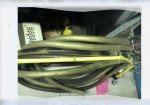We have some VFD and ASD/ 3phase 460 volt for some 125-150 submersable pump / motors . They all have vfd shield - steel type cable[750v] coming from the motors to a local disconnect than to the VFD with a thhn/ thwn cable . Should this cable be in the same class as the shielded cable for a better installation ? Is there a negative using two types of wiring ?
Some use a cable rated at 2000v, I don't know why
There is a phenomenon associated with VFDs called "standing waves" that can create voltage spikes of up to 2000V that bounce back and forth along the cables until they find a place to dissipate, often the first turn in the motor windings because the insulation is slightly thinner there. The spikes are a result of capacitive coupling between the conductors caused by the high speed switching of the VFD transistors (very condensed version of a very complex issue). The problem increases with conductor length, and is therefore a real serious issue for deep well ESPs (Electric Submersible Pumps) in particular. One way to mitigate it is to use special "VFD cable" that nests ground conductors with the power conductors in an overall shielded cable. So some of the smarter ESP mfrs have taken to using this specialized cable. Byt the way, this cable shielding must be grounded at BOTH ends, unlike shielded signal cable grounds. The ESP mfr will have (should have) connected the shield to the pump frame, you have to ensure it is grounded at the disconnect end.
The voltage rating of the cable is not proven yet to be a factor, but some people feel that if these spikes can damage the motor insulation, it can damage the motor leads as well. But like I said, there is little or no research pointing to this as fact, at least not yet.
If you use regular THHN/THWN wire, it MUST be in
steel conduit, and the conduit MUST be bonded to ground. It also is suggested that you triplex the conductors with the ground, or even multiple ground conductors, but I rarely see that done.
If your VFD has what is called a "DV/DT Filter" in it or witrh it, most of this is a non-issue, because that is another way to mitigate the problem.
By the way if you have a disconnect switch between the VFD and the motor, you will also want to have an aux contact in the disconnect that is connected to the Run command of the VFD so that the VFD is in an Off state before the power contacts of the disconnect can close or open.


